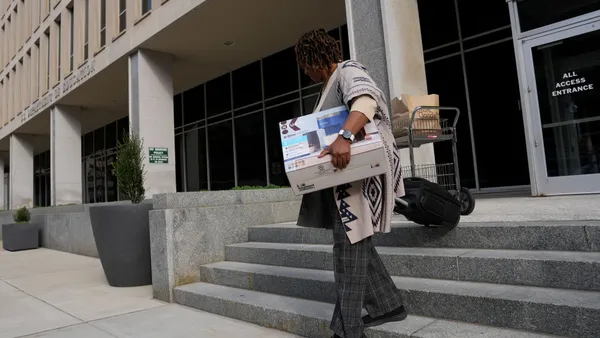Dive Brief:
- New bipartisan legislation in the Senate aims to provide a legal framework for income-share agreements (ISAs), an emerging college financing model in which the institution fronts some or all of a student's costs in exchange for a share of their paycheck for a set period after graduation.
- The legislation calls for capping the percentage of income an individual would pay at 20%, with lower shares for longer contracts, and exempting those who earn less than 200% of the federal poverty line from payments. It would limit repayment to 30 years and allow ISAs to be discharged in bankruptcy.
- Advocates of ISAs say they offer students a lower-risk source of financing, while critics say they amount to debt and note they often are layered atop federal and private loans. But interest has piqued with the U.S. Department of Education's recent suggestion it may pilot one.
Dive Insight:
The House too has put forward ISA-specific legislation. Both come as interest in and scrutiny of ISAs is increasing. Last month, Congressional Democrats pressed U.S. Education Secretary Betsy DeVos for more details on her department's plan to possibly offer an ISA.
They also sent letters to seven colleges that use ISAs, requesting them to provide program details and copies of their contracts.
Some 30 colleges offer or accept ISAs, including the University of Utah, Purdue University and Colorado Mountain College. They tend to view ISAs as a gap financing tool with an eye toward access and equity, covering costs unmet by the combination of federal loans, scholarships and grants, observers told Education Dive last month.
U of Utah, for example, launched its ISA after finding students were taking longer to graduate because a reluctance to take on debt pushed them to work part-time to pay for school. Colorado Mountain College offers an ISA for undocumented students who aren't eligible for federal student aid.
Although ISAs are gaining interest, critics are concerned they are not materially different from student loans, despite being touted as a nondebt alternative. This is largely because students are exempt from monthly payments if they earn below a certain income threshold — which ranged from $20,000 to $40,000 in examples Education Dive observed. Monthly repayment percentages ranged from 1% to 8%. The amount an institution agreed to front also varied.
Some features of ISAs are cause for caution, critics say. Those include arbitration clauses, class-action bans, penalties for early repayment and the potential for extended payment periods if borrowers earned below the income threshold during some months.
How ISAs fit into current law is disputed. Some have been pushing for separate legislation that offers benchmarks for factors such as the maximum payment amount, length of payment terms and tax treatment. But others say current consumer protection laws suffice and that tailoring legislation could cause the industry to seek favorable treatment, Joanna Darcus, staff attorney at the National Consumer Law Center, told Education Dive last month.
Other concerns about the new focus on ISAs include whether they allow colleges to continue raising tuition and whether the Ed Department should focus its priorities elsewhere. In their letter, Congressional Democrats suggested it would be better for DeVos to address a backlog of borrower defense claims or improve the Public Service Loan Forgiveness program.














